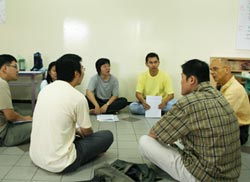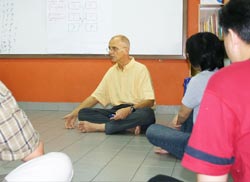Submitted by zhenliang on

On the night of Friday, 30 December 2005, about fifteen people of various ages met for a workshop on MBTI (Myers-Briggs Type Indicator). Most of them were volunteers of Mitra Welfare Centre and the others had come to know of this workshop through friends in the Mitra Welfare Centre.
Dhammaloka, the MBTI Workshop instructor, introduced himself with the aid of a poster drawn by him just before the workshop. He said he was German by birth and is now staying in a meditation retreat centre in Wales. Towards the end of his bachelor degree in music (he played the cello), he had a bad car accident and he took a bachelor degree in sociology and psychology instead. He is an ordained member of the Western Buddhist Order in Britain.
After his introduction, Dhammaloka wanted the participants to do the same, but in groups. He divided the participants into three groups and each of these groups was to present a poster depicting who they were, their common interests and why they were taking the MBTI workshop. After the three groups had discussed and drawn their posters, each group presented their poster. It was a fun and interesting way for everyone to get to know each other. The posters were subsequently hung up in the room for the duration of the workshop.
Dhammaloka then passed round a questionnaire for the participants to answer. He said there was no right or wrong answer to the questionnaire as each individual's answer was right for the person. After everyone had done the questionnaire, Dhammaloka handed out a set of sixteen short profiles and requested everyone to take back, read and choose a profile that best suited them.
The next day, early at 9.00am, Dhammaloka talked about the MBTI's Eight Preferences , namely the pair of Attitudes or Orientation to the Preferred World of Extraversion and Introversion , the pair of Functions for Gathering Information of Sensing and Intuition , the pair of Functions for Ways of Making Decisions of Thinking and Feeling , and the pair of Attitudes or Orientation to Lifestyle of Judging and Perceiving . After explaining each pair of Attitudes or Functions, he requested the participants to pair up, according to the Attitude or Function they felt best suited them, and to discuss certain questions put to them.
At the end of this session, everyone had an idea of his or her type according to MBTI. This was compared with the type given by the answers to the questionnaire and indicated by the choice of the short profiling. In most cases one or two letters of E, I, S, N, T, F, J, and P did not match out of the four letters (e.g. ESTJ, INFP, ENTP) of each type. Dhammaloka said the typing indicated by questionnaires was the weakest and should be discounted if it differed greatly from that indicated by profiling. Dhammaloka also warned against pigeonholing any person when using the MBTI to identify the type that a person is as the psychological profile of any person is too complex to be true to any particular type.
On the last day of the workshop (Sunday, 1 December 2005), Dhammaloka touched on the type dynamics of the sixteen types. It was interesting to learn how the various attitudes and functions of each of the sixteen types interact to produce a complex behaviour. Dhammaloka also taught the hierarchy of the Functions and suggested that we each study our type well and develop (mature) the less dominant functions. He said there was a possibility of a follow-up workshop if the participants were serious in the study of their type and initiated their mental and spiritual development.



